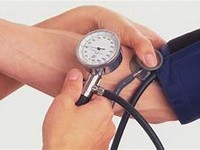
FOODS THAT HARM
Salty and processed foods, such as pickles
FOODS THAT HEAL
Green leafy vegetablesLow-fat dairy productsLegumesFruits, especially bananasNuts and seedsWhole wheat pastaCarrotsSweet potatoes
FOODS TO LIMIT
Fatty foods, especially foods high in saturated fatsAlcoholCaffeinated drinks
WHO’S AFFECTED
About 970 million people worldwide have hypertension, including one in three adults in the U
S
(an additional 30% of American adults have prehypertension)About 45% of African Americans have high blood pressure More than 80 million North Americans have high blood pressure, also called hypertension
In its early stages, high blood pressure is symptomless, so many people don’t realize they have a potentially life-threatening disease
If the condition goes unchecked, high blood pressure damages the heart and blood vessels and can lead to a stroke, heart attack, and other serious consequences
In about 5 to 10% of cases, there’s an underlying cause for high blood pressure—a narrowed kidney artery, pregnancy, an adrenal gland disorder, or a drug side effect
Most often there is no identifiable cause; this is referred to as primary, or essential, hypertension
No one fully understands precisely what leads to hypertension, although a combination of factors seems to be involved
Heredity, diabetes, obesity, and certain other disorders increase risk
Other contributors include smoking, excessive alcohol, and a sedentary lifestyle
Blood pressure also tends to rise with age so all adults over age 40 should have their blood pressure checked annually
NUTRITION CONNECTION
Diet plays a role in both prevention and treatment of high blood pressure
Following the DASH (Dietary Approaches to Stop Hypertension) diet, which is endorsed by numerous health organizations including the American Heart Association and the Mayo Clinic, will help lower blood pressure
Here is a synopsis of the DASH diet and accompanying strategies
Have 6 to 8 servings of grains daily
Focus on whole grains such as whole wheat pasta because they have more nutrients and fiber
Eat 4 to 5 servings each of fruits and vegetables daily
Foods such as carrots, green leafy vegetables, sweet potatoes, and others contain beneficial nutrients that lower hypertension: fiber, vitamins, and minerals such as potassium and magnesium
Consume 2 to 3 servings of low-fat or fat-free dairy foods
Research has shown that a diet that includes calcium-rich foods such as low-fat dairy products helps lower blood pressure
Be careful to watch sodium intake when eating low-fat or nonfat cheeses
Limit meats, poultry, and fish to 6 oz (170 g) or less daily
It’s best to cut back on meat consumption, but when eating it, opt for the leanest cuts of meat
Eat 4 to 5 servings of nuts, seeds, or legumes per week
These foods offer an array of good minerals, but it’s important to watch serving portions as they can be high in calories
Limit fats to 2 to 3 servings daily
Avoid saturated fats and trans fats, which contribute to high blood pressure
A high-fat diet also leads to weight gain
Limit fat intake to 30% or less of total calories, with 10% or less coming from saturated animal fats
This means cutting back on butter and margarine; switching to low-fat milk and other low-fat dairy products; choosing lean cuts of meat; and shifting to low-fat cooking methods, such as broiling instead of frying
Limit sweets to 5 servings per week
There is wiggle room for those who love sweets as long as you watch serving portions
Limit your salt intake
A key component of what makes DASH effective is reducing sodium intake
Keep it at 1,500 mg to 2,300 mg
Beyond putting down the salt shaker, avoid most processed foods, which are usually loaded with sodium
Pump up potassium
Some nutrients may protect against high blood pressure
Potassium, an electrolyte that helps maintain the body’s balance of salt and fluids, helps ensure normal blood pressure
Potassium can be found in fruits and vegetables, such as bananas, dairy products, and legumes
Get your calcium
Recent studies indicate that people with low levels of calcium are at greater risk of high blood pressure
A diet that low-fat dairy products, fortified soy beverages, canned salmon (with bones), and green leafy vegetables will raise levels of calcium and help decrease hypertension
However, the jury is still out on whether calcium supplements help or hinder the condition
Reduce alcohol and caffeine consumption
Although a glass of wine or other alcoholic drink daily seems to reduce the chance of a heart attack, consuming more than this will negate any benefit and may increase the risk of hypertension
Too much caffeine can also raise blood pressure
Older adults with hypertension may be more sensitive to the effects of caffeine and should limit their intake
BEYOND THE DIET
While a proper diet is instrumental in maintaining normal blood pressure, it should be combined with other lifestyle changes, such as: Exercise
Aerobic exercise lowers blood pressure by conditioning the heart to work more efficiently
In addition, even a modest weight loss will cause a drop in blood pressure
Quit smoking
Nicotine raises blood pressure
Quitting can drop blood pressure by 10 points or more
Reduce stress
Stress prompts a surge in adrenal hormones and a temporary rise in blood pressure; some researchers believe that constant stress may play a role in developing hypertension
Meditation, yoga, biofeedback training, self-hypnosis, and other relaxation techniques may help lower blood pressure
Use medications with caution
Over-the-counter cold, allergy, and diet pills can raise blood pressure
In some women, birth control pills or estrogen replacement therapy can cause high blood pressure
Try drug therapy
If these lifestyle changes do not decrease hypertension to normal levels in 6 months, drug therapy is often instituted
Treat underlying conditions
Diabetes and elevated blood cholesterol, both of which compound the risk of developing heart problems, may associated with high blood pressure